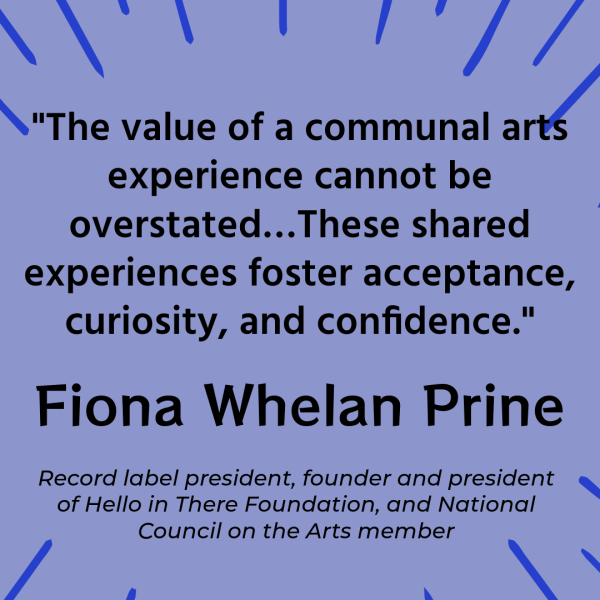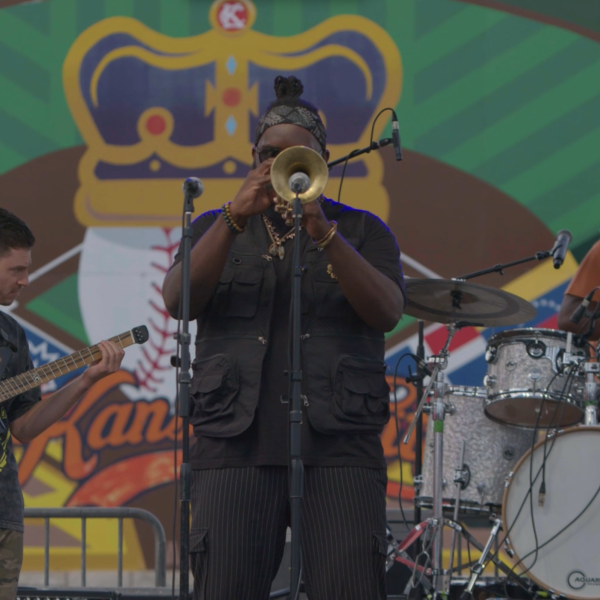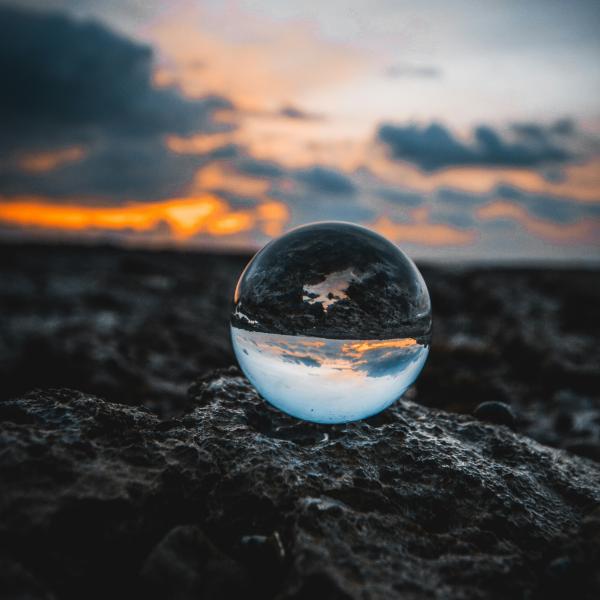At the Intersection of Art and Science: A Conversation with Rebecca Rutstein
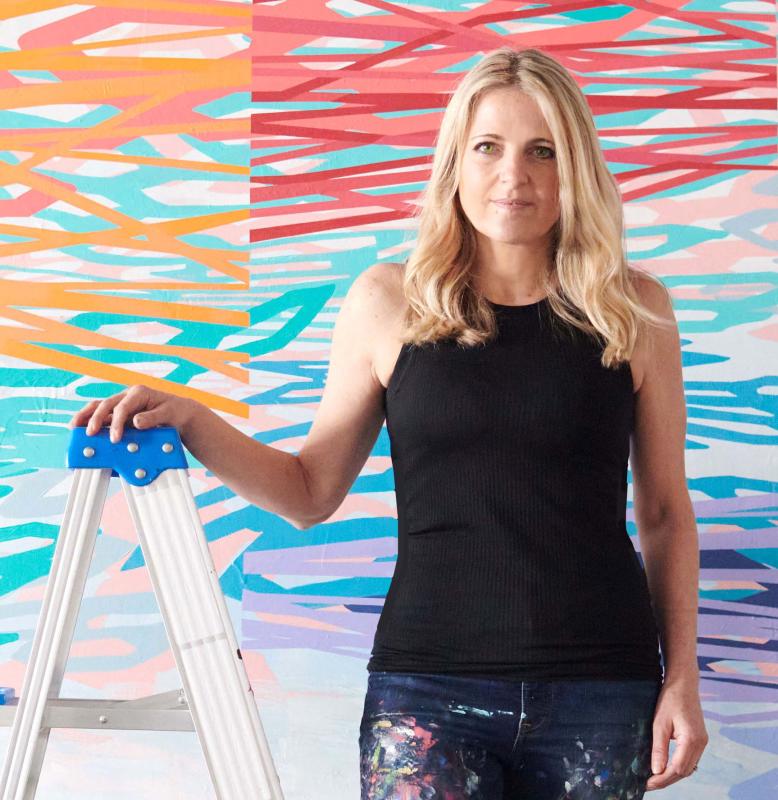
Rebecca Rutstein in her studio in Philadelphia, Pennsylvania. Photo Courtesy of Rebecca McAlpin Photography
Rebecca Rutstein is a multidisciplinary artist and ocean explorer who has spent over two decades working at the intersection of art and science. Her diverse body of work, which encompasses painting, sculpture, interactive installations, and public art, draws inspiration from the natural world. What brought Rutstein to this intersectional work? Here’s how she described her aha! moment: “During my 2005 residency in Hawaii while studying the active Kilauea volcano, I came across a multi-beam sonar map of the ocean floor, revealing a complex, mountainous landscape imaged through sound waves. This hidden world beneath the surface stoked my curiosity on the vast mysteries of the deep ocean and the technologies allowing us to see it. I wanted to go there. It was this moment that essentially launched the last 18 years of my artistic career, in ways I would have never thought possible.”
Throughout her career, Rutstein has actively sought out partnerships with experts from various scientific and artistic fields and gained a unique perspective on the interconnectedness of natural systems. These collaborations have broadened her understanding of the intricacies of the natural world and influenced her artistic practice. Through Rutstein’s immersive installations and visuals, she reveals the hidden aspects of nature that often elude our perception. Her work illuminates the unseen places and processes, shedding light on the beauty and fragility of our environment. By bringing these hidden elements to the forefront, Rutstein aims to cultivate a deeper connection with nature and inspire a sense of curiosity, compassion, and humanity.
With a passion for exploration, Rutstein has embarked on numerous artist residencies worldwide, including seven voyages at sea and two deep-sea dives in the Alvin submersible (with another expedition and dives planned for 2024). Rutstein said “Having a window into these worlds and to witness first hand these phenomena has been one of the great honors of my life. I’m keenly aware that few artists have the opportunity to dive in Alvin, so I feel a sense of duty to share these revelations through my art practice, to illuminate this hidden world for others.”
Rutstein has received numerous accolades for her work, including a Pew Fellowship in the Arts, designation as an MIT (Media Labs) Ocean Discovery Fellow, and a recent appointment as the Delta Visiting Chair for Global Understanding at the University of Georgia. Rutstein's work has been featured on NPR, ABC, CBS and in the Wall Street Journal, HuffPost, and Vogue UK.
We spoke with Rutstein about her journey as an artist working at the intersection of art and science, her creative process when working on a project, the symbiotic relationship of art and science, and the importance of exploring unchartered territory—in and out of the sea.
NEA: Can you tell us more about your journey as a multidisciplinary artist?
REBECCA RUTSTEIN: I always knew I wanted to be an artist. Drawing is one of my earliest memories, an instinctive, steady, and almost meditative practice that pervaded my youth along with every scrap piece of paper, napkin, or notebook I could get my hands on. It no doubt helped me process some early childhood struggles like my parent’s divorce. My connection with nature evolved more slowly. I recently came across a handwritten and illustrated account I wrote about the ocean at the age of ten, my only keepsake from elementary school, and a preamble of what was to come.
As an art major in college in the early 90s, on a whim I took a geology class, where we visited state parks around the town of Ithaca to learn about geologic forces first hand. The Finger Lakes region is a wild display of waterfalls and gorges, where streams have eroded monumental layers of exposed, sedimentary shale rock (once deposited at the bottom of an ancient sea) to reach deep, finger-shaped lakes gouged out by glaciers some 10,000 years ago. These dramatic landscapes tell a story, and it was absolutely stunning. This visual way of learning had a huge impact on me, and while I wasn’t painting about these landscapes during my time at Cornell [University], I most certainly fell in love with geology. Years later, on a cold morning in my Philadelphia studio, I was leafing through my old geology textbook and came across plate tectonic diagrams illustrating the shifting of earth’s plates. All at once, this idea of forces underneath the surface causing upheaval above, resonated for me as a metaphor for my own tumultuous relationships—the friction, tension, collision, separation, erosion, and upheaval that I was experiencing in my 20s. And so, I began exploring the use of these diagrams and maps in my paintings.
NEA: Can you talk more about the shift in your artistic path as you started integrating science into your art practice?
RUTSTEIN: This search for metaphor launched me into a genuine, decades-long journey with geology that led me to pursue art residencies around the world where I researched, explored, and created site-specific projects in geologically dynamic places including the Canadian Rockies, the Big Island of Hawaii, Iceland, and even in my own backyard in the Crum Creek Woods of Pennsylvania.
It would be another 10 years, in 2015, before I got out on a research vessel and started actively collaborating with scientists at sea. Sailing for three weeks from the Galapagos to San Diego on the Nautilus Exploration Vessel with scientists mapping the ocean floor, I found the experience absolutely thrilling while I [also] felt at peace. My husband jokes he never saw it coming that I’d become a sailor, but that trip changed me as a person.
At the same time, my artistic practice expanded from a solitary painting practice (I earned my BFA and MFA in the field of painting) to include sculpture, interactive installation using LED light programming, public art, video, and sound. This multidisciplinary approach happened organically over time as projects unfolded and I searched for the right medium to best tell the story. The same year I went out to sea for the first time, I also created my first public art project, Sky Terrain, a 40’ x 70’ permanent outdoor installation at Temple University incorporating 18 laser-cut steel sculptures and LED programmable lights and sensors, with a team of engineers, fabricators and designers. Working with a team of experts in their fields allowed me to expand the scope of my practice in new and exciting ways.
NEA: How do you decide if you want to say “yes” to a project?
RUTSTEIN: I want to create work that resonates beyond the aesthetic experience. As my practice has evolved and expanded, and I find myself able to be selective about the kinds of projects and collaborations I pursue, I’m most interested in saying “yes” to projects that have meaning to me, where I will learn something about the world, that involves collaborating and exchanging ideas with interesting and inspiring people, that has the potential to offer immersive experiences for myself and ultimately in the art that is created… which can immerse the viewer in a story to connect them more deeply with the natural world in the face of our climate crisis.
NEA: Your collaborations with oceanographers, ecologists, geologists, and microbiologists have provided you with a broad understanding of the interconnectedness of systems in the natural world. How have these collaborations shaped your perspective as an artist?
RUTSTEIN: I’ve learned so much about how patterns repeat themselves universally at different scales, and how microbial networks mediate processes on our planet. I’m fascinated by the invisible worlds that exist alongside ours that we just aren’t tuned into. Whether it’s deep sea microbial networks, underground fungal networks connecting trees, intricate crystal structures in billion-year-old meteorite fragments, or cellular networks communicating within our own bodies, the more I learn about systems in the natural world, the more I understand how everything is connected in nature. More importantly, I’ve come to really appreciate that we, humans, are not separate from, but are part of that system. I know this seems obvious, but for many there is a real separation from the natural world in our day-to-day lives. Trying to move from an exploitation mindset to a regeneration mindset is something that has really become a driving force in my work. I want to create work that opens a window between the viewer and the natural world and creates connection and wonder, inspires empathy, and fosters greater understanding.
NEA: How do partnerships between the arts and science communities benefit the community at large?
RUTSTEIN: I think it’s incredibly important for people to get out of their individual silos and sit at the table together. This is the only way forward if we are to solve the greatest global challenges of our time, like our climate crisis. Artists can play a critical role in communicating with and moving the general public by creating the expressive and emotional drivers that scientific data lacks.
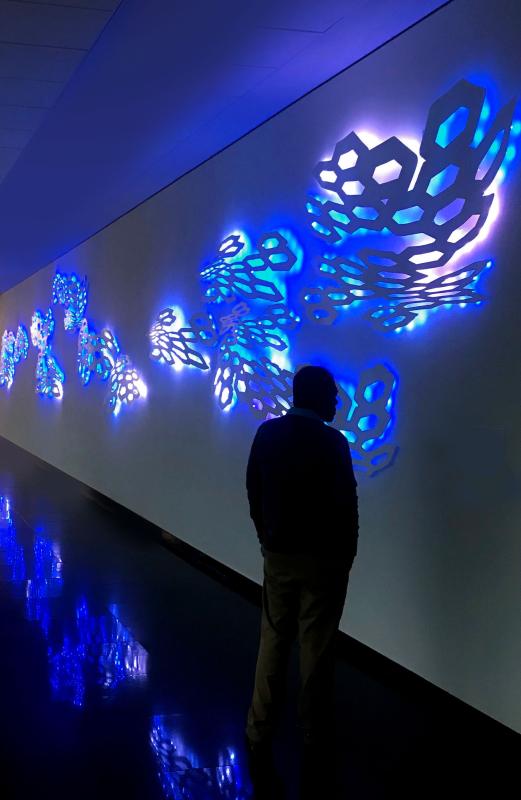
A visitor observing Rebecca Rutstein's interactive installation, Shimmer, in the permanent collection of the Georgia Museum of Art in Athens, Georgia. Photo Courtesy of Rebecca Rutstein
NEA: Describe your creative process when working on a project. How do you navigate the intersection of creating art that is visually captivating while also conveying scientific concepts or messages about the natural world?
RUTSTEIN: I first want the viewer to have a visceral experience with the work. The scientific messages and the stories are there to be unpacked within an abstract or “abstracted” visual language upon further observation, or by reading accompanying wall text. I’m interested in making the invisible visible, by amplifying hidden or microscopic systems in the natural world. This might mean making a 22-foot tall painting installation inspired by microbial networks at the bottom of the ocean, or a 64-foot long interactive sculpture that mimics bioluminescent signals from deep sea marine organisms. In the latter, the Georgia Museum of Art said of my interactive sculpture, Shimmer, “It’s not only beautiful; it’s a great example of how science and art can work together to communicate new information.” My work is really about joy; it’s about reveling in the wonder of nature. There are plenty of important artists addressing climate change in their work, and while I’ve created data-driven work before, my general approach is to shed light on the beauty and sublimeness of the natural world.
When I start a collaborative research project with a scientist, I spend a lot of time listening and learning and writing. I often gravitate toward certain components of their research that grab me, that I want to delve into further. Sometimes I will see certain visual data that is compelling and that represents patterns I’ve seen before that I want to explore creatively. It’s a give and take. My scientific collaborator might also respond to something I’ve observed or created, as it reminds them of another component of their research, or compels them to think about their data in a whole new way. There is a synergy with the back and forth, unscripted conversations that lead to more revelations and greater understanding, pushing everyone into unchartered territory.
NEA: Can you share your experience as an artist-in-residence on expeditions at sea and dives to the ocean floor in the Alvin submersible? How have these immersive experiences influenced your artwork and understanding of the ocean's mysteries?
RUTSTEIN: It’s been completely life changing and almost impossible to put into words. Diving in Alvin was a lifelong dream realized. It awakened something metaphysical and almost primal. Slowly descending the water column for an hour and a half in complete darkness, while seeing flashes of pulsing light from bioluminescent life dazzling all around you like dancing stars, is unlike anything I’ve ever seen before. You feel like a tiny speck in a vast and otherworldly universe. The submersible is a six-foot diameter titanium sphere that houses two scientists and a pilot for nine hours, not a party for someone claustrophobic. The vessel is ambient temperature with the ocean depths, so it gets to about 33 degrees Fahrenheit, requiring you to wear lots of layers (no synthetic fibers, to minimize the risk of fire). Once at the extreme depths of the ocean floor between 1,800 and 2,200 meters where we dove (in Guaymas Basin, Mexico, and off the coast of Costa Rica), there are chemosynthetic worlds completely foreign to how we understand life to function on our planet… bizarre ecosystems where organisms feed off of bacteria (called “extremophiles”) which get their energy from chemicals, rather than sunlight, coming out of the ocean floor at hydrothermal vents or seeps.
The expeditions themselves are amazing and exciting experiences. On the research vessel, the science team, engineers and crew become a family. I typically set up a make-shift painting studio, working alongside the scientists in a common lab area, and create paintings in situ inspired by data being collected and my own personal observations. There is always someone doing a job at any given hour on a ship, with a head popping in to chat about the paintings unfolding at sea, whether it be the captain, an engineer, a custodian making his rounds, or a postdoc. On a vessel, everyone has a part to play and there is a great amount of synergy with the shared goal in running a smooth ship and a successful science operation. Being embedded with the science team and even participating in some of the operations is essential in terms of learning about the research being conducted, having unscripted and meaningful dialogues with the scientists, engineers, and crew, making connections across disciplines and bringing together diverse voices for a shared experience and deeper understanding of our world.
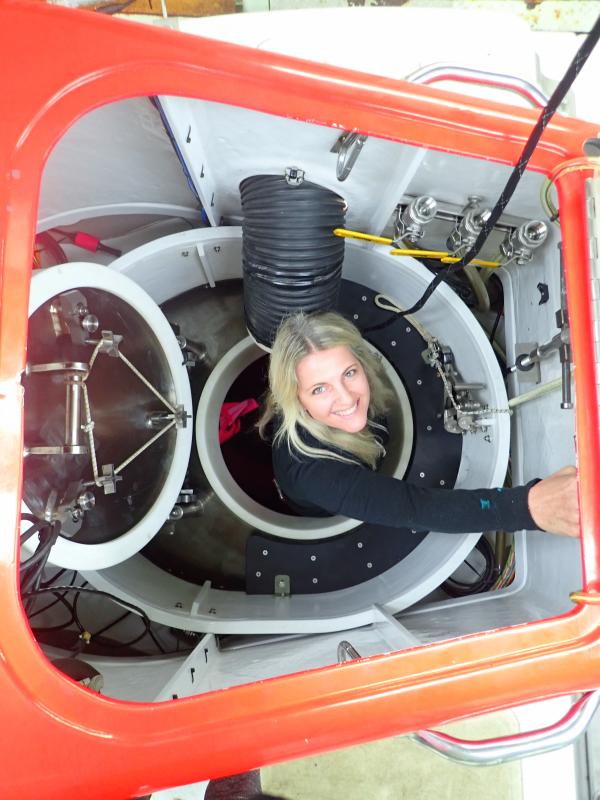
Rebecca Rutstein emerging from the Alvin submersible during an expedition off the coast of Costa Rica in 2018. Photo Courtesy of Avery Hiley
NEA: Your artwork is featured in numerous public collections, including prestigious institutions and organizations. What does it mean to you to have your work showcased in these settings, and how do you hope it impacts viewers?
RUTSTEIN: I feel honored to be included in these collections. And as a woman, having my work collected by institutions where predominantly male artists have historically been represented, I feel proud to be part of this collective moment towards more equitable representation. Still, recent research shows that works by female artists make up just 11 percent of acquisitions by art museums, and even less by Black artists of both genders. There is an emerging drive for interdisciplinary exchange and collaboration, as a means to foster greater understanding and to solve the pressing global issues of our time. Having my science-inspired artwork exhibited and collected by both art and science institutions is evidence of that. Encouraging viewers to step out of their silos to understand the world through a different lens is one way I hope to impact viewers.
I’m excited about opportunities to reach the public beyond these institutional walls. It’s expanded my practice both in terms of allowing me to push the scale of my work and to create the kind of access I want my work to have with the general public.
NEA: Can you share details about your current exhibition, Blue Dreams, at the National Academy of Sciences?
RUTSTEIN: Blue Dreams is an immersive large-scale video installation that integrates abstract imagery, rare deep-sea video footage, and computer modeling (animating one of my paintings) to portray the resilience and growth of our planet’s smallest yet most vital living systems in the deep ocean. Microbial networks thrive in these extreme environments on the ocean floor and are essential to the functioning of our planet: they produce the air we breathe, regulate ocean chemistry, and are the origins of life on Earth. Oceanographer Sylvia Earle once said that “for every drop of water you drink, and every breath of air you take, you are connected back to the sea.” This immersive video installation is meant to inspire awe and wonder at these systems, processes, and landscapes otherwise hidden from view, and that seem so far away from our reality, but that connect us to our past and which we rely on for our own survival.
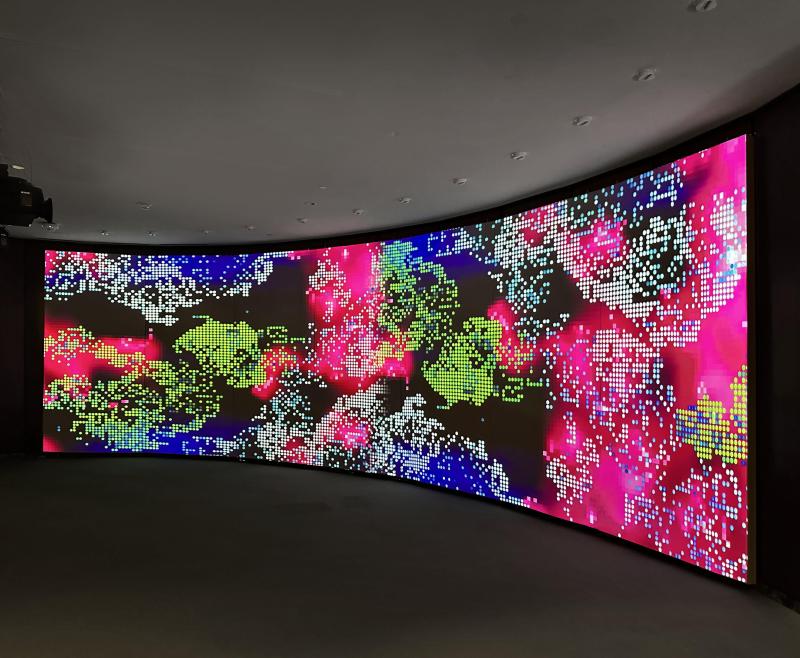
Rebecca Rutstein's immersive video installation, Blue Dreams, a collaboration with scientists of the Ocean Memory Project—supported by National Academies Keck Futures Initiative—on view at the National Academy of Sciences in Washington, DC. Photo Courtesy of Alana Quinn
NEA: How do you know if a project is a success?
RUTSTEIN: Whether it be a painting, sculpture or a more immersive installation, my goal is always, first and foremost, that the viewer has a visceral experience through the visual language of art. This experience can be heightened and enhanced by gaining a deeper understanding of the scientific phenomenons behind the work. If the viewer can get lost in the work and feel a sense of wonder or curiosity and want to learn more, that would demonstrate to me it was a successful project.
NEA: How do you envision your work evolving in the future?
RUTSTEIN: As my work continues to evolve, I am interested in creating more immersive, multi-sensory experiences that connect the public with the natural world. In particular, I am in the midst of a long-term collaborative work involving three other artists and two scientists called the Immersion Project, which is a vision for a large-scale, immersive and interactive art installation inspired by deep-sea coral forms that will have a second life as an artificial reef in the Gulf of Mexico. This project will incorporate 3D printing, ceramic casting and weaving to create modular, monumental, coral-inspired structures filling an exhibition or public space. The interactive installation will also incorporate audio that combines field and hydroponic recordings, interactive lighting to simulate bioluminescent communication, and an augmented reality layer to create a multi-sensory undersea experience. After the traveling exhibition cycle along the Gulf coast, portions of the exhibited forms will be deployed on the ocean floor as a form of remediation through direct human intervention, in a coordinated effort with NOAA [National Oceanic and Atmospheric Administration]. This could have a significant positive environmental impact in the ecological recovery and restoration of the Gulf of Mexico’s deep coral gardens damaged during the Deepwater Horizon oil spill of 2010.
I hope to continue to push the boundaries of what I can do creatively, get out of my comfort zone, delve into more large-scale public works that can reach a broader audience, and continue to create work that resonates beyond aesthetics. People have often joked with me, "what's next, are you going to the moon?" The truth is, that if given the opportunity, I would covet the chance to explore deep space, and see it as a natural progression of my explorations to immerse and learn about the natural world. So, to be continued!


